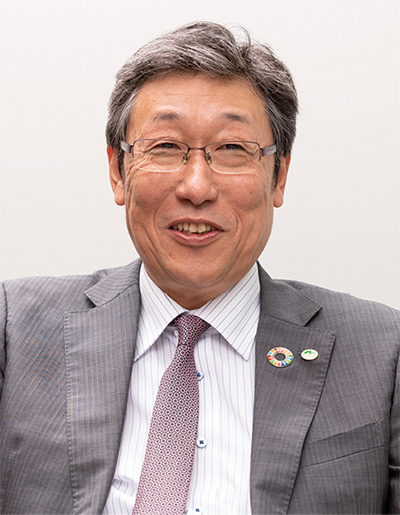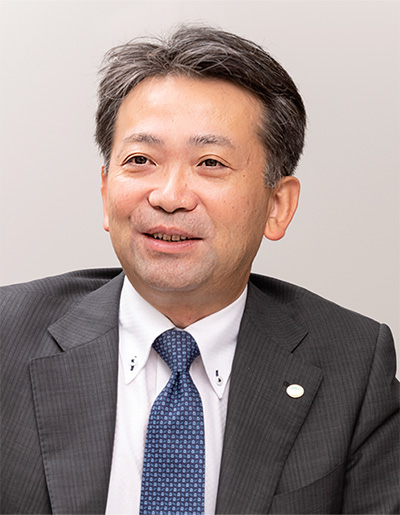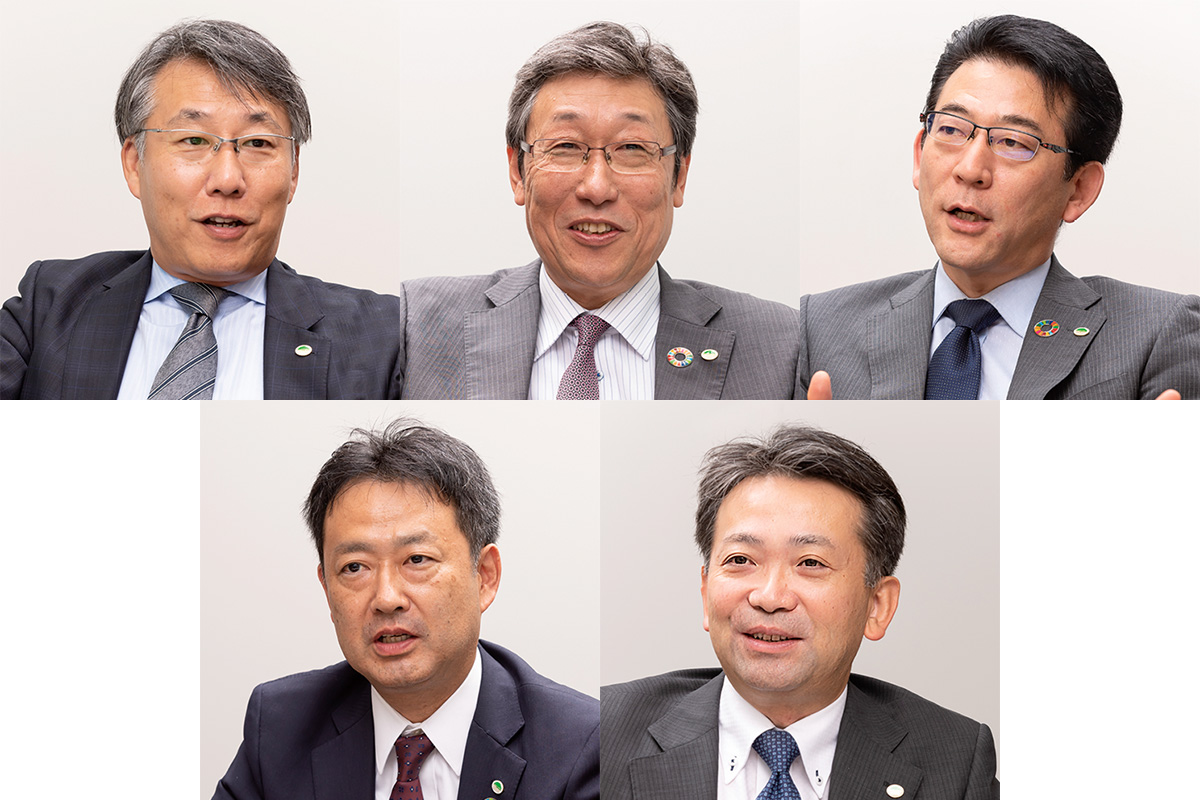Seeking to Implement Total Seamless Solutions

Kazunobu Morita
General Manager, Business Strategy Planning Division
CSO & CTO, Industry Business Division, Hitachi, Ltd.

Kenjiro Fujii
Executive Managing Director
Group Executive, Business Operations Group
Hitachi Industrial Equipment Systems Co., Ltd.

Kazuhiro Imaie
Board Director
General Manager, Business Strategy Division
Hitachi Industrial Products, Ltd.
Mikami: The role of industrial products, the value chain, and business practices have been going through major changes in recent years. While industrial markets have been seeing greater use of new technologies such as the Internet of Things (IoT) aimed at achieving the Sustainable Development Goals (SDGs) and Society 5.0, how can industrial products help achieve Hitachi’s goal of solutions that seamlessly link workplace and management? Can you please start by telling me about your current activities?
K. Morita: A number of business divisions and subsidiaries exist within the Hitachi Group that deal with the industrial market. These include Hitachi Industrial Products, Ltd. and Hitachi Industrial Equipment Systems Co., Ltd. as well as the Industry & Distribution Business Unit (BU) and Water & Environment BU of Hitachi, Ltd. We group these together as Hitachi’s “Industry sector,” with our role at the Industry Business Division being to coordinate these organizations and business areas and to facilitate their working together seamlessly to create value for customers. The aim of the Industry sector is to deliver value by tying workplaces and management together through the concept of total seamless solutions that add value to data while also seeking to acquire manufacturing know-how.
Fujii: Hitachi Industrial Equipment Systems has primary responsibility for mass-production products within the Industry sector. Whereas the requirements placed on our products in the past mainly related to specific improvements such as enhancing production line functions or cutting costs, we now need to consider products that deliver optimization at the factory level or even the entire world. Along with use of the latest technologies such as artificial intelligence (AI) for analyzing data and other such tasks, the objective of achieving system-wide optimization in a distributed manner also requires connectivity with other machinery, equipment, and platforms, with Lumada playing a central role. Hitachi Industrial Equipment Systems is making progress on implementing the IoT using both communications equipment and connected equipment. The former include IoT-ready controllers equipped with their own information processing capabilities that connect to control systems via shared memory, and communications modules that can be used in global areas. The latter include air compressors and inkjet printers.
Imaie: Hitachi Industrial Products operates its business on the basis of three key points: “built-in drive,” meaning key products to be incorporated into the main unit; “connected products,” meaning connecting products to other devices and equipment; and “recurring business,” meaning after-sales services such as maintenance services, etc. While the infrastructure equipment we deal with, which includes non-mass-production motors and inverters, do not in themselves constitute total systems, the mission-critical role these products fulfill in industry and other parts of society means that failures or other problems can have major consequences. We provide not only a rapid response in such cases, but also make optimizations in close collaboration with customers through the supply of solutions that use data collected over long periods to prevent failure or loss.
A. Morita: Collaborative creation with not only customers, but also a variety of other stakeholders is essential to create new business value by utilizing digital technologies, which enable us to bridge between workplace and management, and also connect us with other companies and different industries within the supply chain. We use the idea of “boundaries” to refer to the challenges that arise from connectivity, and overcoming these boundaries is both of value to customers and a business opportunity for Hitachi. Collaborative creation with customers is the mission of our Global Center for Social Innovation in the Research & Development Group. They engage in research and development utilizing an open innovation base in Japan, Kyōsō-no-Mori (Co-creation Forest), also in cooperation with overseas research centers. The Center for Exploratory Research, meanwhile, takes a long-term view to the building of the Social Innovation Business and seeks out possibilities for more advanced collaborative creation while engaging in vigorous debate not only with other staff, but also with people from outside Hitachi.
Creating Future Industrial Products through Data and Collaborative Creation

Ayumu Morita
Deputy General Manager, Center for Technology Innovation
General Manager, Hitachi Research Laboratory
Research & Development Group, Hitachi, Ltd.

Hiroyuki Mikami
General Manager, R&D Center
Hitachi Industrial Equipment Systems Co., Ltd.
Mikami: The role of industrial products, the value chain, and business practices have been going through major changes driven both by connectivity and the means of achieving that connectivity. What do you believe we need to do to adapt to these changes?
A. Morita: One major issue is how to think about the next generation of manufacturing, including logistics and maintenance. The Research & Development Group is developing technology based on the three layers of generating data from products, using it for the optimal control of sites, and linking in to enterprise resource planning (ERP) across the entire value chain. One example is a technique that uses motor current to determine the motor condition itself, and also that of connected machinery. This approach of focusing on parts where the amount of particular characteristics presenting themselves rather than attaching measurement sensors is something that Hitachi is able to do thanks to its more than 100 years of involvement in the research, development, and manufacture of electric motors. We have developed the digital-twin solution, which consolidates operational technology (OT) data such as equipment operating conditions and IT data such as production plans in cyberspace, and uses techniques like AI analysis and simulation to help optimize all steps in the production process. We are steadily building up our portfolio of use cases and I believe we can approach the ideal of the smart factory by successfully tying these together.
Fujii: For a machine tool manufacturer, the use of motor currents to determine the status of other machinery is a revolutionary advance. The Research & Development Group has helped us with research into predictive diagnosis and maintenance for our inverters and I look forward to working with you on building inverters that know the status of other machinery.
K. Morita: While we talked earlier about “boundaries,” actually the problems that arise from connectivity most likely already existed in the workplace. It was the collection of data that brought them to light. The task of picking in warehouses, for example, involves workers walking to the shelves and taking out the ordered item from among those stored there. It was a detailed analysis of the data that prompted the idea that moving the shelves would be faster. The innovation of using self-guided robots to transport the shelves came about, I believe, as a result of analysis using numbers and graphs that was made possible by digitalization. This is an example of how the source of value lies in the workplace, and our aim is to study our customers’ businesses and realize value by combining data on men, machines, materials, and methods (4M) with information from other sources such as ERP and financial data.
A. Morita: Unfortunately, however much data you have, you will still not know what to do unless you also have a physical model and understand the physical processes involved. I believe the way forward is to use traditional practices and digital technologies in tandem.
K. Morita: That is right. While the tendency is always to focus on the latest trends, this sort of new pillar comes from a basis of pursuing manufacturing. The source of competitiveness lies in making good use of both the new and the old, and this is what leads to progress in industrial products. Moreover, given that innovation arises out of thinking differently, it is also important to foster people who will come up with this new thinking. This will lead to benefits for customers and to the creation of new business in various forms.
Fujii: We should not forget that, like many of our customers, we too are manufacturers. In manufacturing, we need to keep up with the latest trends and build systems that we ourselves find compelling. We must always have an answer to the question: “What is Hitachi doing about this?” I believe that our customers have confidence in Hitachi as an industry player equipped with products, OT, and IT.
Imaie: A customer recently commented that, “You need skills in the workplace to take advantage of the IoT. That is why we intend to work with Hitachi.” As well as being extremely delighted, this also left me with sobering thoughts. It may be that growing by working together conscientiously like this will be essential in the industry of the future.
How Reliability Supports Service Businesses, and the Globalization of Design, Production, and Distribution
Fujii: People say that we are transitioning from mono-uri (the sale of goods) to koto-uri (the sale of services). However, to gain the benefit of services we also need to maintain reliability. Information systems play an important role in doing this efficiently and at low cost. In the case of the industrial inkjet printers of Hitachi Industrial Equipment Systems, the people who service the product have access to the customer’s dispatch and installation records as well as quality control data from the factory. In other words, by maintaining electronic records from production to disposal, we are establishing the practices that underpin the service business. While people in the past were reluctant to release quality data, they are now prepared to do so as a way to “sell quality” or “sell reliability.”
K. Morita: When value is generated from the sale of services, goods are enhanced by that value, and a virtuous circle forms in which it is used to develop new products that can then be supplied back to customers. Asking how this can be turned into positive outcomes is a key point for building strength in industrial products.
Mikami: In the cycle of goods, services, and goods, there is an impression that, for example, environmental regulation brings not only innovation in the product itself, but also a change in how the customer perceives value in the product. In the case of products such as inverters and permanent magnet motors for railways and automobiles, while value is also created through functional improvements provided by adopting the product, I feel that customers have come to think about the procurement of products and systems in terms of savings on the lifecycle cost of power consumption.
K. Morita: The meaning of lifecycle is also associated with investment considerations. How much return can you expect from a given investment? At a data center, for example, if batteries can be made more efficient by increasing their energy density, they will deliver a higher return to customers thereby making them a more efficient investment. As global competition intensifies, we are entering an era in which manufacturing companies also need to get more deeply involved in the realm of investment.
Fujii: Speaking of global activities, Sullair, LLC, a major US manufacturer of air compressors became part of the Hitachi Group in 2017. As we are also involved in the air compressor business at Hitachi Industrial Equipment Systems, we have started working together on optimizing our global manufacturing operations. This includes starting to think about how to allocate the production of parts across our plants in Michigan (in the USA), Japan, China, and Malaysia to achieve better investment efficiency. We are also working on standardizing our design data to align it with the three-dimensional drawing data currently held by Sullair, whereas Japan has traditionally used drawings with two-dimensional data. We have also embarked on the unification of design and the optimization of manufacturing sites by undertaking the digitalization and standardization of upstream processes like design at the same time as we are sourcing production in accordance with the equipment available in each region, and we have started to set up a parts supply system that will reduce logistics costs in our recurring business.
Imaie: At Hitachi Industrial Products, too, we are assigning design work based on what the design departments in each region are best equipped to work on, and looking at how to take advantage of the time differences between overseas sites and Japan and to get products to market more quickly.
K. Morita: I very much hope you proceed with that because, in manufacturing, the vertical engineering chain (EC) of planning, prototyping, design, and production has tended to be overlooked compared to the horizontal supply chain. This is not just about becoming more competitive, but also about the EC because it is becoming a major theme in delivering value to manufacturing customers.
A. Morita: When it comes to design, the railway business faces similar challenges. The work on building a global innovation database that makes the different technologies built up in the UK, Italy, and Japan available for others to use by putting it into a matrix is finally starting to take shape.
Fujii: Hitachi Industrial Equipment Systems has also been involved for many years in businesses that deal with the Global Positioning System (GPS) and positioning information. We can provide a variety of traceability functions, including remote surveillance and monitoring of products, by treating time and position as links to physical space and building a digital database on these two axes.
Sharing Exciting Work Leads to Social, Environmental, and Economic Value
Mikami: Hitachi is taking on new challenges with the aim of creating a sustainable society. In closing, can each of you give me your thoughts on these initiatives, please?
K. Morita: The idea of people engaging with each other in exciting work has emerged as a significant concept over the last few years in contexts such as the SDGs and quality of life (QoL). This is true for Hitachi, for our customers, and for our customers’ customers. When everyone is energized, it enhances value for people and that flows into environmental value and social value. The Industry sector is at the forefront of pursuing this approach and I would be delighted to see it adopted more widely within Hitachi.
Fujii: Talking about wanting to do exciting work sounds like a very good thing. Everyone feels excited when things go better than expected. To that end, we first need to have a dream we want to pursue. Having a dream shows you what you want, and having something you want infuses you with the strength to seek it in reality. What is important in such cases is to build up shared know-how and put it into practice. By having a large portfolio of use cases, Lumada supports people when they are looking for the shortest route to achieving their goals, and also helps them share a sense of enthusiasm.
Imaie: In terms of technology trends, whereas some technologies grow incrementally, others come down to the present out of ideas of a distant future. In addressing sustainability, we always need to be considering matters from a management perspective and paying attention to whether our industrial products and businesses are in tune with the expectations of society and with trends among customers and technology.
A. Morita: In its pursuit of open innovation, the Research & Development Group gives consideration to three things: technology development, the building of ecosystems, and public acceptance. The Hitachi-UTokyo Laboratory was established as one such initiative and over the last few years has been bringing together a variety of people from organizations such as the Agency of Natural Resources and Energy and the Ministry of the Environment to discuss the form that energy systems might take in 2030 and 2050. Details of this work are presented publicly at an annual forum. In these discussions, we gain a deeper understanding of the genuine issues and what sort of future we want, and consider what sort of technologies we should be providing. As industrial equipment should play an important part in this, we are hoping for a world that many people can enjoy, including how the visions we come up with can be translated into practice.
Mikami: Hitachi’s 2021 Mid-term Management Plan talks about improving people’s QoL as well as about creating a sustainable society encompassing improved social, environmental, and economic value for customers. I hope we can create total seamless solutions that connect workplace with management and the physical realm with the cyber realm while also engaging in exciting work alongside customers and others. Thank you for your time today.


